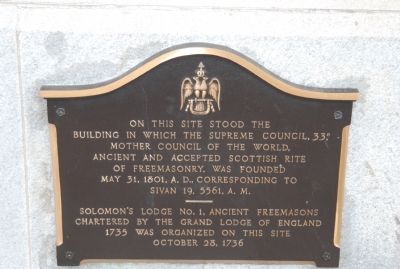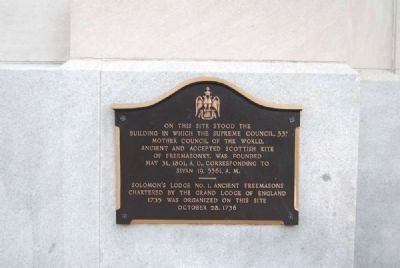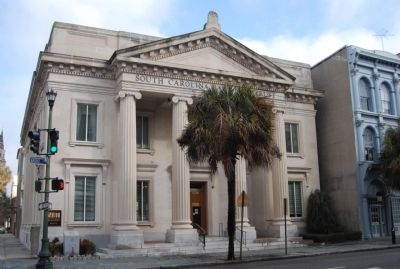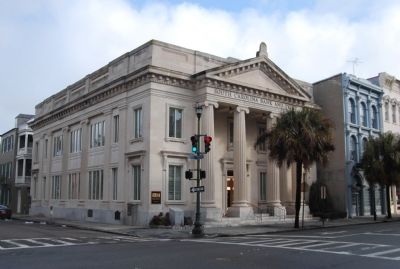French Quarter in Charleston in Charleston County, South Carolina — The American South (South Atlantic)
Ancient and Accepted Scottish Rite of Freemasonry / Solomon's Lodge No. 1
Inscription.
building in which the Supreme Council, 33°,
Mother Council of the World,
Ancient and Accepted Scottish Rite
of Freemasonry, was founded
May 31, 1801, A.D., corresponding to
Sivan 19, 5561, A.M.
—————
Solomon's Lodge No. 1, Ancient Freemasons
chartered by the Grand Lodge of England
1735 was organized on this site
October 28, 1736
Topics. This historical marker is listed in this topic list: Fraternal or Sororal Organizations. A significant historical month for this entry is May 1850.
Location. 32° 46.607′ N, 79° 55.753′ W. Marker is in Charleston, South Carolina, in Charleston County. It is in the French Quarter. Marker is at the intersection of Church Street and Broad Street, on the right when traveling north on Church Street. Marker is located on the side of the building. The current building houses the South Carolina Bank and Trust. Touch for map. Marker is at or near this postal address: 46 Broad Street, Charleston SC 29401, United States of America. Touch for directions.
Other nearby markers. At least 10 other markers are within walking distance of this marker. Shepheard's Tavern (here, next to this marker); The Society of the Cincinnati of the State of South Carolina (here, next to this marker); The Grand Lodge of Ancient Freemasons of South Carolina (a few steps from this marker); Old Bank Building (within shouting distance of this marker); William A. Giles (within shouting distance of this marker); Clark Mills Studio (within shouting distance of this marker); Broad Street Site of Domestic Slave Trade (within shouting distance of this marker); The Confederate Home (within shouting distance of this marker); Bible Depository (about 300 feet away, measured in a direct line); Daniel Ravenel II House (about 300 feet away). Touch for a list and map of all markers in Charleston.
Also see . . .
1. Scottish Rite of South Carolina. Website homepage (Submitted on February 14, 2010, by Michael Sean Nix of Spartanburg, South Carolina.)
2. Scottish Rite of Freemasonry, SJ, USA. Website homepage:
Located at 1733 16th Street, NW, in Washington, D.C., this monumental edifice has been the national headquarters of the Supreme Council, 33°, Southern Jurisdiction, since 1915. (Submitted on October 2, 2011, by Brian Scott of Anderson, South Carolina.)
3. Scottish Rite. Wikipedia entry:
The Ancient and Accepted Scottish Rite of Freemasonry (the Northern Masonic Jurisdiction in the United States often omits
the and), commonly known as simply the Scottish Rite, is one of several Rites of the worldwide fraternity known as Freemasonry. (Submitted on October 2, 2011, by Brian Scott of Anderson, South Carolina.)
Additional commentary.
1. The Eleven Gentlemen of Charleston - The Founding Fathers of the Scottish Rite
John Mitchell
Received a patent April 2, 1795, from Barend Moses Spitzer granting him authority as Deputy Inspector General to create a Lodge of Perfection and several Councils and Chapters wherever such Lodges or Chapters were needed. Born in Ireland in l741, he came to America at an early age, was Deputy Quartermaster General in the Continental Army, and the first Grand Commander of the Supreme Council.
Frederick Dalcho
A physician. He served in the Army and for a while was stationed at Fort Johnson. He formed a partnership with Dr. Isaac Auld, another of the original members, in 1801. He was an outstanding orator and author. In 1807 he published the 1st Edition of Ahiman Rezon. He became an editor of the Charleston Courier, was a lay reader and deacon in the Episcopal Church and in 1818 was ordained a Priest.
Alexander Francois Auguste de Grasse Tilly
A son of a French Admiral, and perhaps the most famously connected of all the original eleven. He was the youngest of the members and was named to become the Grand Commander of the West Indian Islands. He later moved to France and established the Supreme Council of France.
Jean Baptiste Marie deLaHogue
He was a native of Paris and was a member of La Candeur Lodge in Charleston.
Thomas Bartholemew Bowen
Was the first Grand Master of Ceremonies of the new Supreme Council. He was a Major in the Continental Army and a printer by trade.
Abraham Alexander
Was one of the first Sovereign Grand Inspectors General. He was born in London in 1743, immigrated to Charleston in 1771. He was a very prominent Jew and had been described as "a Calligraphist of the first order", which may account for his election as the first Grand Secretary General.
Emanuel de la Matta
A Sovereign Grand Inspector General. He was by trade a merchant and auctioneer. He was a member of Friendship Lodge and was reported to be quite devoted to the study of Jewish Literature and Masonic Study.
Isaac Auld
An eminent physician, associated in medical practice with Dr. Dalcho. He was a rigid Congregationalist.
Israel de Lieben
A Sovereign Grand Inspector General and the first Grand Treasurer General. He was born in Prague and emigrated to America upon reaching Majority age. He was known as "the liberal-headed Jew", who was "tolerant in his religious opinions and was considered to be intelligent, enterprising, liberal and generous.
Moses Clava Levy
Was born in Krakow, Poland. He was a prosperous merchant, was generous and helpful to the unfortunate and devoted to his adopted city and country.
James Moultrie
Was the only native South Carolinian among the original members. He was a Doctor of Medicine, and according to Albert Pike, "was one of the foremost Citizens of South Carolina". (Source: Wikipedia article on the Scottish Rite, Birth of the Scottish Rite section.)
— Submitted October 2, 2011, by Brian Scott of Anderson, South Carolina.
Credits. This page was last revised on February 16, 2023. It was originally submitted on February 14, 2010, by Michael Sean Nix of Spartanburg, South Carolina. This page has been viewed 1,825 times since then and 93 times this year. Photos: 1. submitted on February 14, 2010, by Michael Sean Nix of Spartanburg, South Carolina. 2. submitted on October 2, 2011, by Brian Scott of Anderson, South Carolina. 3, 4. submitted on February 14, 2010, by Michael Sean Nix of Spartanburg, South Carolina. • Craig Swain was the editor who published this page.



